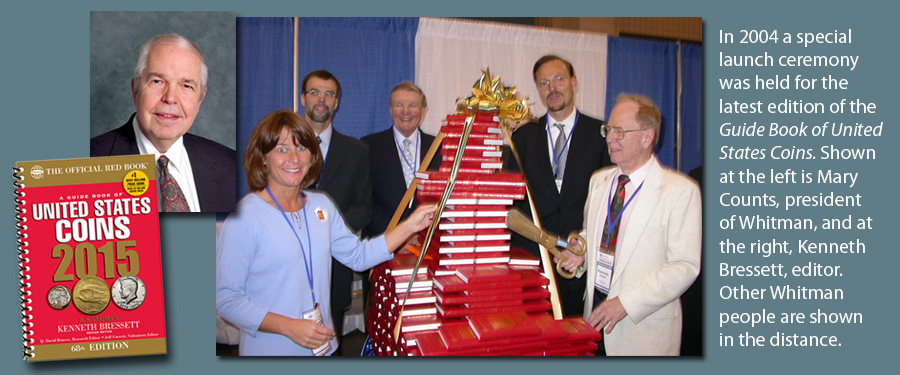
I continue my discussion of A Guide Book of United States Coins, the familiar red-covered volume edited by Richard S. Yeoman and launched by Whitman in 1946. A cover date of 1947 was given so as to prolong its shelf life when displayed in hobby stores, bookshelves, and elsewhere. The "Guide Book," nicknamed the "Red Book," became an instant bestseller. The current edition is the 68th and was published in 2014 with a cover date of 2015. As you read these words, the 2016 edition is being printed. Release will be in the spring.
Last week I told more about the origin of this popular text. This week I continue, beginning with the title page. For a long time the senior editor has been Kenneth Bressett, although the name of the late R.S. Yeoman is prominent. Ken, a printer by trade, joined Whitman many years ago when the firm was located in Racine, Wisconsin. He soon emerged as the leading researcher there, made many innovations, helped produce additional titles, and took the "Guide Book" to new heights of information and usefulness. After leaving Whitman, Ken worked for a time with Arthur M. Kagin, after which he and his wife, Bert, moved to Colorado Springs, where he joined the staff of the American Numismatic Association doing research, working with the American Numismatic Association Certification Service to authenticate and grade coins, and to participate in many other activities. Later her retired, sought election to the ANA board of governors, succeeded, and eventually became president.
In the meantime, Whitman underwent transitions, and the Guide Book was sold to St. Martin’s Press in New York City. Ken Bressett continued as editor. Shortly after the turn of the present century, Anderson Press, based in Florence, Alabama, acquired the rights to the Guide Book. Whitman Publishing, LLC, was set up with its office in Atlanta, Georgia, and its fulfillment center in Florence. This set the pace for vast expansion and improvement. Mary Counts (now Mary Counts Burleson) was named president to manage the business end of the enterprise. Dennis Tucker is the publisher, Ken Bressett is the senior editor and makes the final decisions, Jeff Garrett is listed on the cover and title page as valuations editor, and I am featured as research editor. As a team we work with many contributors to the Guide Book, a list of whom can be found on page 7 of the current edition.
To be accepted as a contributor, those interested must demonstrate market and numismatic knowledge to Ken Bressett and Dennis Tucker, and also need to contribute each year information concerning prices, comments about editorial matter and more. Most of the contributors have specialties. Some are experts on, for example, Morgan and other silver dollars, others on gold, still others on colonial coins. There are contributors beyond those who do annual pricing, and they are listed under “Special Credit” in the book, a schedule of some of the most prominent names in numismatics. A nod is also given to those who have helped in the past but no longer live or are not current contributors.
Page 8, “How to Use this Book,” gives quick instructions as to abbreviations, how prices are compiled, and more. This is very useful for newcomers who have just purchased a copy and want to get started — without having to read pages of other information. Similarly, when you buy a camera, electronic gadget, or something else, there is usually information on how to get started very quickly.
Page 8 notes that prices are compiled two months prior to the time each edition goes to press. This process begins in the summer, goes into high gear in the autumn, and at the Atlanta office under the guidance of Dennis Tucker, is completed in early January. Also on that page is a quick overview of the market:
“Prices rise when (1) the economic trend is inflationary and speculators turn to tangible assets as a hedge, or when the number of collectors increases, while coin supplies remain stationary or decrease through attrition of melting; (2) dealers replace their stocks of coins only from collectors or other dealers, who expect a profit over what they originally paid; (3) speculators attempt to influence the market through selective buying; or (4) bullion (gold and silver) prices rise.
“Prices decline when (1) changes in collecting habits or economic conditions alter demand for certain coins; (2) speculators sell in large quantities; (3) hoards or large holdings are suddenly released and cannot be quickly absorbed by the normal market; or (4) bullion (gold and silver) prices decline.
“Those who edit, contribute to, and publish this book advocate the collecting of coins for pleasure and educational benefits. A secondary consideration is that of investment, the profits from which are usually realized over the long term based on careful purchases.”
The above information is worth noting, as many newcomers to the hobby are mainly interested in prices and whether their coins will increase in value. The art and science of numismatics is much more than that.
More next week.





